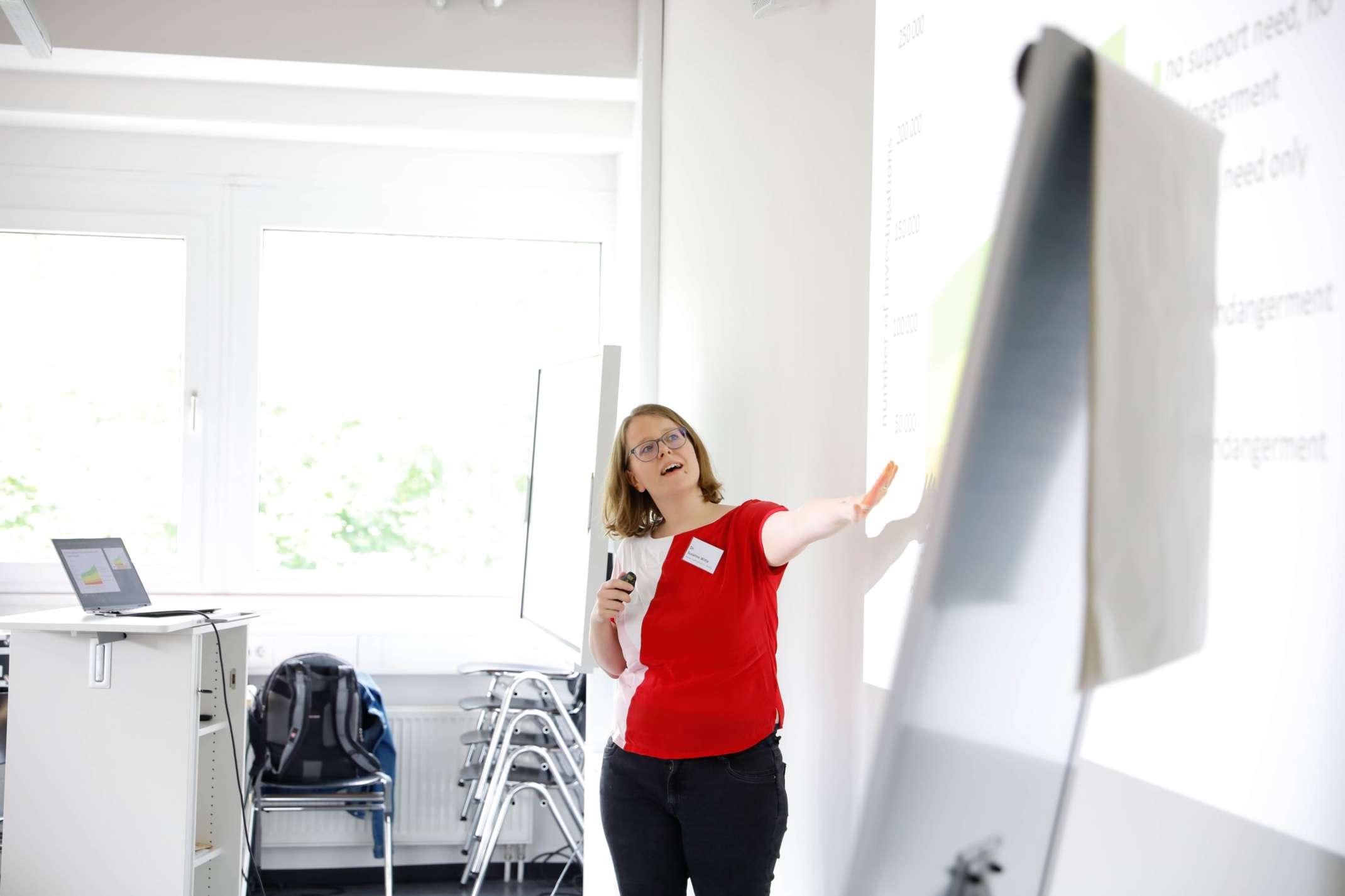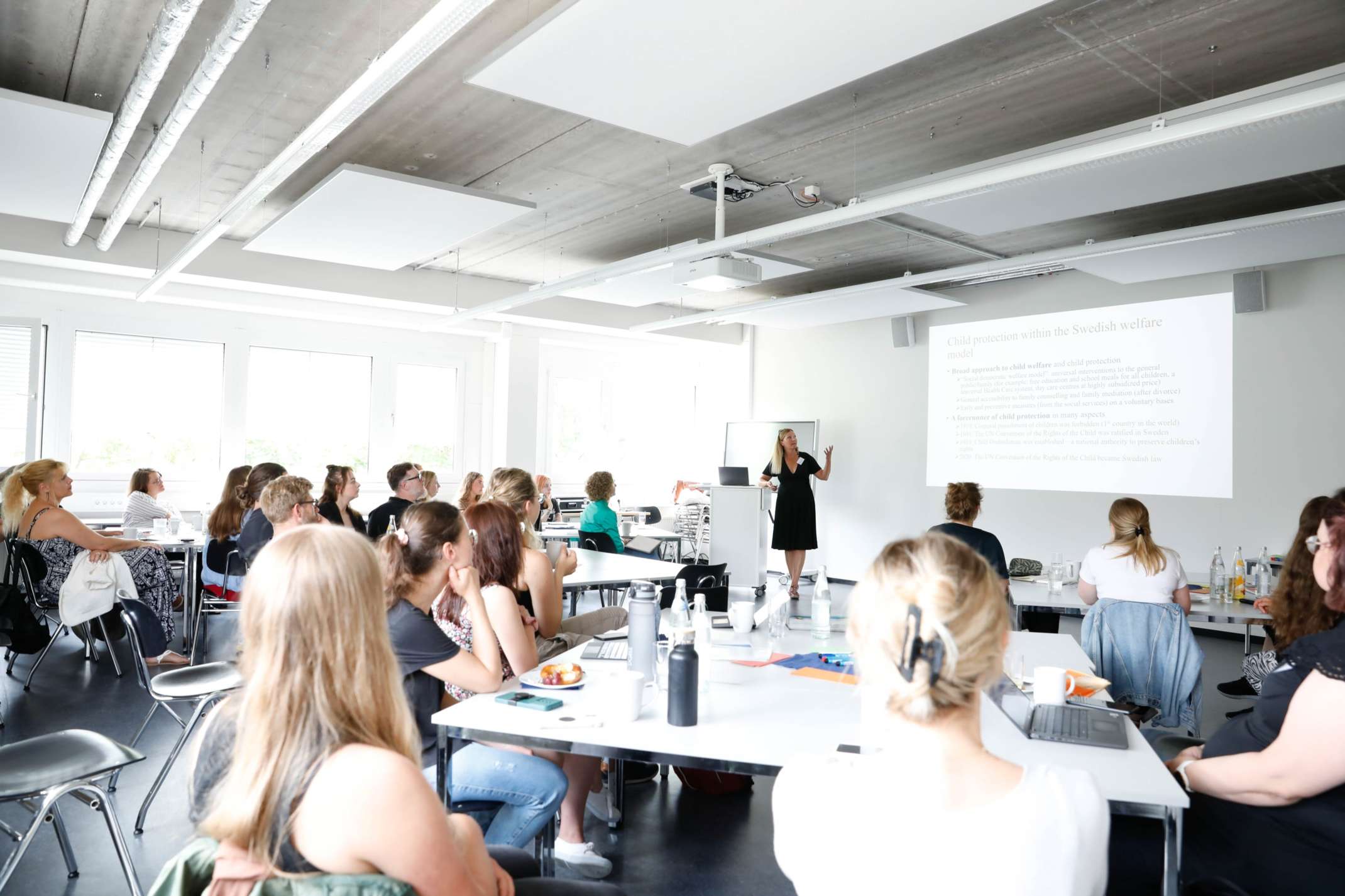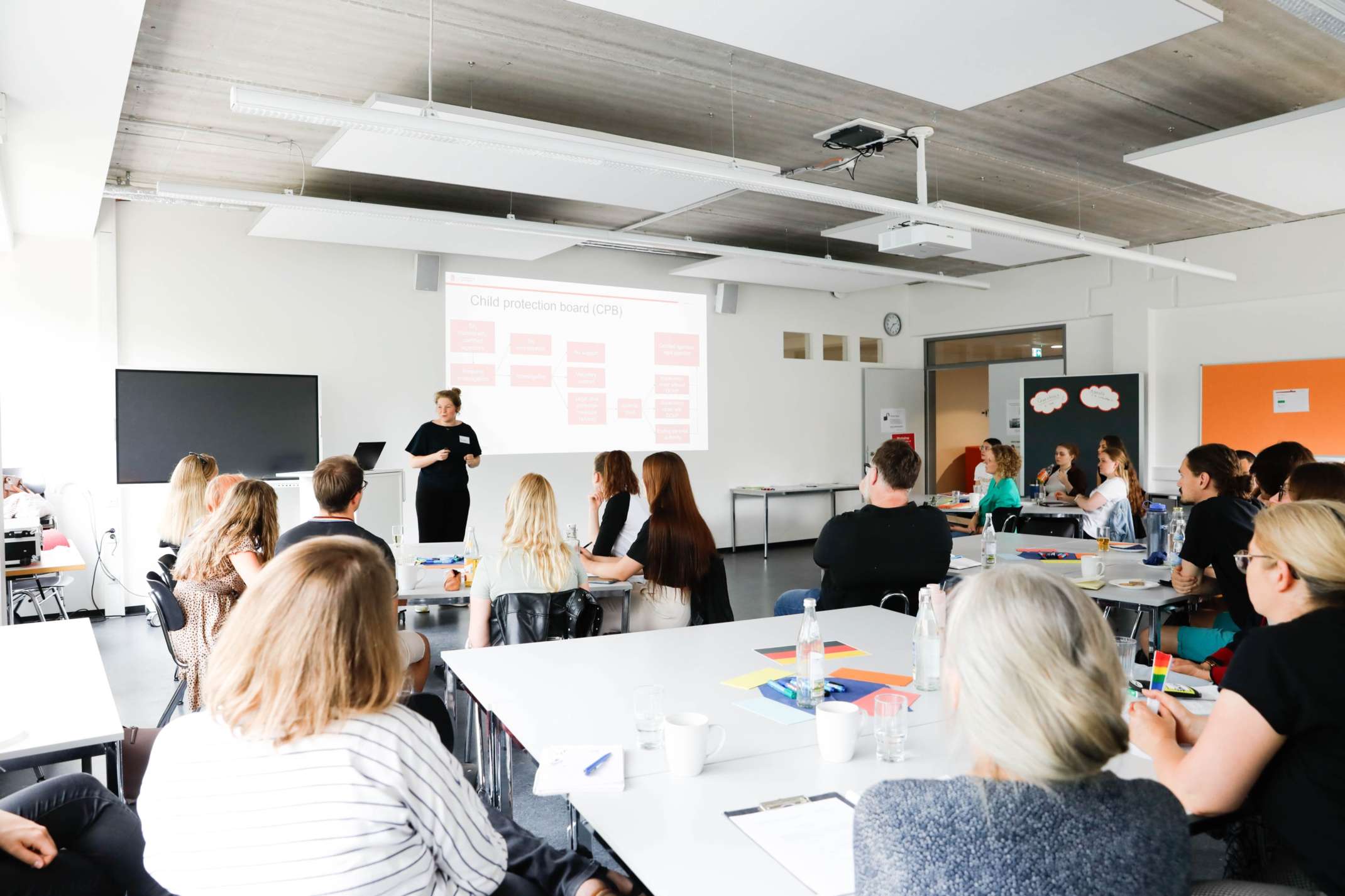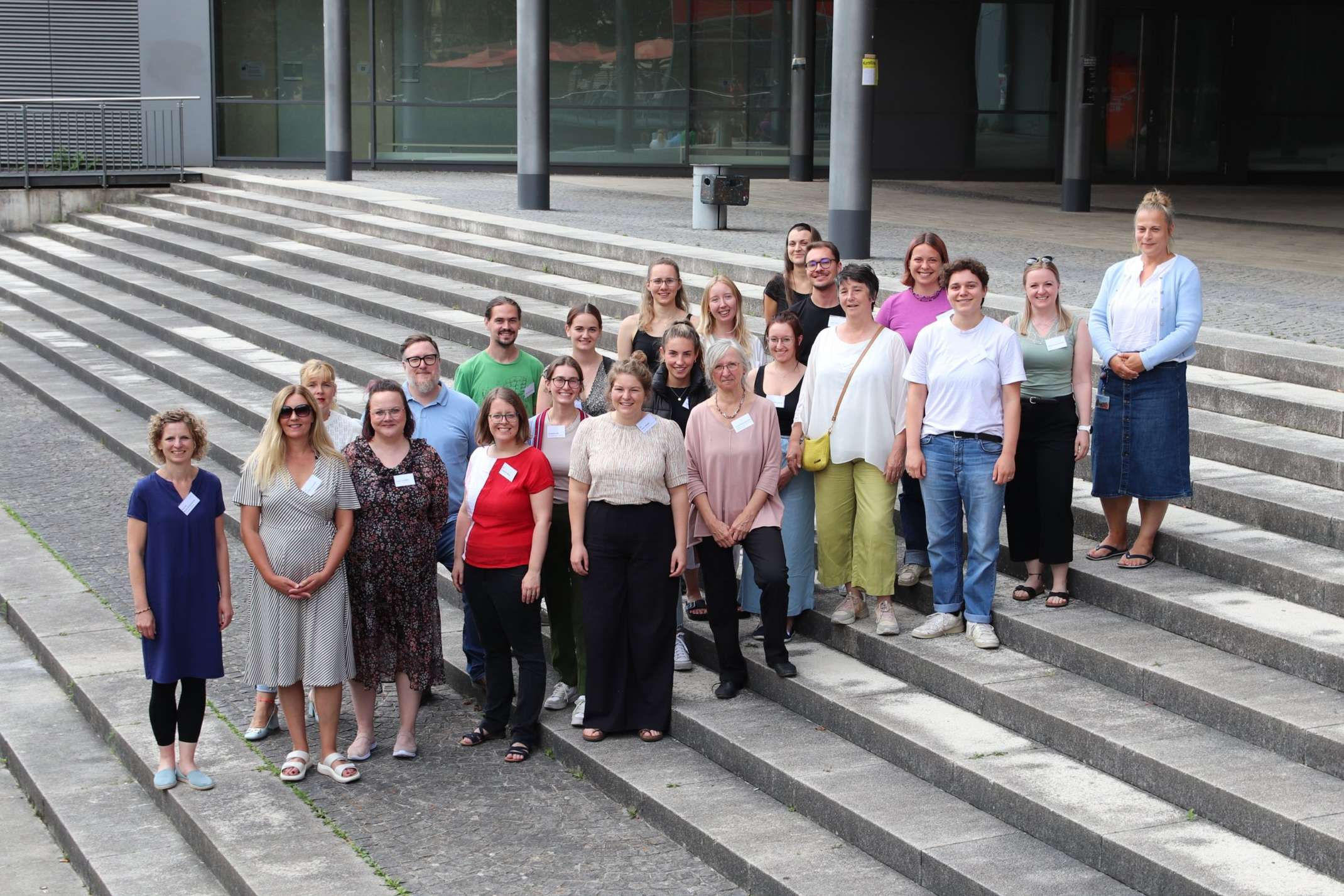
Workshop National Systems of Child Protection
During the summer semester, students of the 4th semester in Social Work had worked on the scientific basics and approaches of child protection in the Federal German system. In addition to studying theory and research results, local stakeholders were invited to bring in their practical perspective. The aim of the workshop was to deepen the findings on child protection research and practice during the semester and to rank them in a comparative European context. For this purpose, selected countries, their state-regulated systems and stakeholders, as well as existing research findings on the situation in child protection – especially in the post-Corona period – were discussed.
Different countries, concepts and conclusions
Dr Floor Middle from the University of Groningen explained the governance structure of the Dutch child protection system. There are two child protection agencies: The “Advice and reporting centre for child maltreatment and domestic violence” (AMHK)/Safe Home that everybody can contact who is worried about the safety of a child. The professional of Safe Home has the discretion to transfer an advice into an actual report with further steps of measures or a report into an advice . The second agency is the “Child Protection board” (CPB) that can just be addressed by public stakeholders like municipalities or certified agencies. Depending on notification given, further investigations and support measurements are organised. Hence, there is a broad structure given for handling child maltreatment on the state level. At the same time, the system is quite fragmented and a lot of different stakeholders and professions are involved. Research indicates that just a fraction of child maltreatment is reported to the agencies. 1,2% (2022) of the children in the Netherlands is part of a child protection measure; almost half of these children live in out-of-home care. Furthermore, there seems to be a discrepancy regarding the awareness of child maltreatment between professionals and children themselves: Whereas professionals assume that 3% of children experienced maltreatment in the past year, 12-17-year old children estimated this figure on 12%. This indicates another important aspect Floor Middle has presented: Children’s participation in child protection. Research results show that this participation is limited in practice. Even providing children with necessary information (needed for successful participation) does not happen very often. So one important question for further discussion is how children affected by child maltreatment can be heard and reached more effectively.
The Swedish child protection system is often described as one with a strong family support perspective, where interventions are mainly directed to parents in order to strength the family as a whole. Dr Ulrika Levander from the University of Lund illustrated how this perspective is rooted within the tradition of the Swedish welfare state model. Sweden was the first country in the world where physical punishment against children was forbidden in 1979. Also, it belonged to the first states that ratified the UN Convention of Rights of the Child. Nevertheless, Sweden has been criticized by the UN Committee on the Rights of the Child for not sufficiently considering the child’s views and voices. Though current reforms intend to strength the position of the child, child protection regulations show the strong legal position of parents. Hence, there seems to be an imbalance between the rights of a child and the rights of parents. There have been recent reforms on domestic violence that oblige authorities to mandatory reporting to social services if they suspect a child in danger. The presented data indicate that in 2021 for approx. 10% of Swedish children a mandatory report was drafted indicating suspected violence or abuse. Two-third of the reports concerned children under the age of 12. Almost half of the reports (45%) did not result in further investigation though. In order to offer an integrated model for handling child abuse, the “Barnahus” with different social and health care services as well as the police was implemented in 2005. Furthermore, there is a debate on extending evidence-based practice with manuals and standardized programs, which – according to Ulrika Levander – need to be seen critical. Instead of the holistic relational approach that have characterized the Swedish child and family welfare system, the emphasis is now laid on more risk management and control, rather than needs-based assessment. Detailed legal regulations enforce more control of social work practice, which has lately caused that more professionals are leaving the field. With regard to future perspectives, the focus is on how the system of child protection can provide quality care for children, strengthen their perspective as well as on the question, how conditions for Social workers can be improved.
On the second day of the Workshop, Paula Vainikka from the University of Lapland presented an overview on the Finnish system of child protection. This system relies on three pillars:
(1) basic level services for families with children (e.g. counselling for parents, prevention work),
(2) child-protection measures like non-institutional care or emergency placements for children and,
(3) foster care and child protection after care (e.g. after care services for young adults under the age of 25, foster care for children under the age of 18).
Responsible for the different services in child protection are the welfare regions (beforehand this was organised on the level of the municipalities). In Finland, a licensed social worker is responsible for the child's affairs; hence, he/she plays a central role in child protection. Legitimized by law, social workers have exceptional power and responsibility in assessing child maltreatment issues and organising services, e.g. urgent out-of-home placements. This decision is supported by a multi-professional examination of the child’s situation. Although the law guides the social worker's work, there is still free space for case-by-case consideration, underlining the need for highly qualified and reflective social workers. In the latest reform of the Child Protection Act, the number of clients per social worker was reduced to a maximum of 30 children by the beginning of 2024. According to Paula Vainikka a good initiative, but there are not enough qualified social workers in child protection. Compared to the other systems, the Finnish system has undergone some profound changes with regard to the orientation principles and structural working conditions. Similar to Sweden, the support of parents and the family used to play a key role within the organisation of child protection measures. Within the last decades though, the perspective and position of the child has been strengthened. In 1983 the child became an independent subject with own rights. The Child Protection Act in 2007 supported children’s individual rights position. Describing the Finnish system is a challenge though: Paula Vainikka characterises the system as one of constant changes and reforms. However, this emphasis the public concern on children’s well-being, reforms can hardly be put into practice due to the constant change.
Dr Susanne Witte, who is a senior researcher at the German Youth Institute in Munich, gave an overview on the main features and governance context of child protection in Germany. Due to the federal state organisation, Witte points out that there is not “one system” of child protection in Germany. Rather there are different specific policies and forms of child protection organised and offered on the level of the state (Land) and municipalities. Susanne Witte underlined the importance of defining the approach to child protection, since there is a narrow and a broad definition. Interventions in cases of child maltreatment base on the principles of the federal Social Code Book and the law on child protection and include a narrow understanding. Preventive measures, like the program “Early help” of the governance that include parenting programs, present a rather broad understanding. Looking back in time, Susanne Witte shows that interventions into families were going done in number until the beginnings of the 2000s, whereas the focus on strengthening early help and prevention and children’s rights rose in importance. With regard to the governance context, the child and youth welfare system with the “Jugendamt” (youth welfare office) is central stakeholder in child protection. The office carries out investigations in cases of suspected child endangerments and handles emergency placements of children. In order to offer services and support for children, the office cooperates with providers (freie Träger). They are also key stakeholders within the system. With the implementation of the latest child protection law, child protection experts were installed to counsel professionals in social services in cases of suspected endangerment, report child maltreatment and provide help and support. Due to the expansion of preventive services, professionals from educational and health services are also part of the complex local network of child protection. Similar to the other presented countries, the child protection system in Germany can be characterised as a multi-level, multi-stakeholder and multidisciplinary field. Looking at research data, Susanne Witte illustrated that the participation of children in German child protections increased within the last years, but it still remains on a very low level. Though there is no comparable data on child outcomes, the existing survey data indicates some weaknesses in the existing child protection systems: the project “Kinderschutzkarrieren” reported a share of 33,3% of re-reports within two years, where 55,6% where caused by child endangerment. Furthermore, the project found that there is a lack of stable living environment for children due to a change of services and measures. Also, the well-being and mental health of endangered children is very fragile. These results are very important for the future debate on the further development of the child protection systems in Germany and they underline the need of more sufficient knowledge about children’s outcomes.
Similar Challenges

It turned out that, despite the differences in history and welfare state context, the principles of sociorganisation and partly the terminology, the different systems face similar challenges. This includes the recruitment and targeted retention of qualified specialists in child protection, the improvement of the prevailing framework conditions or the strengthening of preventive services for children and families. Hence, offering high quality and needs-based child protection arrangements is a future task everywhere. Also, strengthening the rights and voices of children is a similar challenge in all countries. Especially in child protection it is necessary to take the perspective of children into account in arranging a sufficient and suitable service for them. It seems like children are mostly not seen or heard when it comes to making very powerful decision on their lives.
It was also notable that there are clear research gaps with regard to child protection processes and child outcomes in all countries. In all countries there are “blindspots” with regard to the reported child maltreatment cases. Especially with regard to sexual abuse, higher numbers can be expected. Thus, there is little available data on how children develop in child protection systems and how their well-being can improved. Interestingly, the consequences of the corona-pandemic seemed not to be an issue in Finland, Sweden or the Netherlands. There were hardly any or no lockdowns of childcare centres or schools, so that children more or less maintained their daily routines and social workers were able to keep in touch. Today, post-pandemic consequences are not really being discussed in these European countries. Due to much stricter lockdown policies, the situation in Germany differs.
Exchange between University, Research & Practice
In addition to experts from Finland, the Netherlands, Sweden and Germany and the students from the fourth semester, also students from the sixth semester as well as practice partners from Augsburg attended the workshop. This exchange between students, researchers from different countries and local practitioners from Augsburg was, according to a summary of the workshop, extremely profitable. Thus, the scientific findings were reflected not only in terms of how these can be applied into practice, but also with regard to the question on which demands the complexity of child protection places on the university education of future professionals in Social Work. Overall, in all countries it is clear that this is one of the key issues for strengthening child protection everywhere in the long term.
The role of internationalisation in Social Work
When we look at the history of Social Work as profession and discipline, internationalisation has always played a central role. Already in the early 19th century social workers from different parts of the world met and discussed working methods and traditions.
The workshop is one instrument in order to internationalize the study programme of Social Work in Augsburg. One central goal is to learn more about taking over different perspectives, analysing different working contexts for social work and developing a shared understanding of working areas like child protection.
Being asked what the benefit of international workshop-meetings like these is, the experts answered the following:
„I feel like social work is not something you can only do nationally“ (P. Vainikka).
„We have been listening to each other and see different perspectives on child protection from different European countries perspectives and in that reflections are awoken within yourself and you automatically compare with your own situations“ (U. Levander).
„It really helps you to gain different perspectives“ (F. Middel).
“As a researcher, I would say it’s really important for research to be better linked to practice” (S. Witte)
The academic insights gained were not only reflected in terms of application and practice, but also with regard to the question of what demands the complexity of child protection places on the higher education of future social work professionals. In all countries it is clear that this is one of the central questions in order to sustainably strengthen child protection everywhere.



